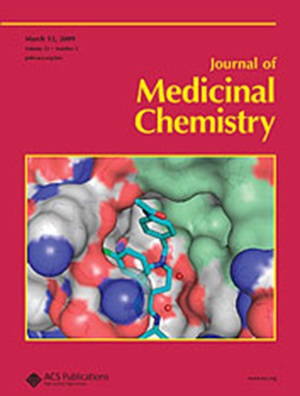Discovery of 1-(Phenylsulfonyl)-1,2,3,4-tetrahydroquinoline Derivative as Orally Bioavailable and Safe RORγt Inverse Agonists for Potential Treatment of Rheumatoid Arthritis
IF 6.8
1区 医学
Q1 CHEMISTRY, MEDICINAL
引用次数: 0
Abstract
The retinoic acid receptor-related orphan receptor γt (RORγt) is a key regulator of Th17 cells, associated with autoimmune diseases, making it a significant drug target. Herein, we designed and synthesized 1-(phenylsulfonyl)-1,2,3,4-tetrahydroquinoline derivatives, improving upon GSK2981278 to enhance bioavailability. Of which, D4 exhibited superior bioavailability (F = 48.1 and 32.9% in mice and rats, respectively) compared to GSK2981278 (F = 6.2 and 4.1%, respectively), and effectively treated psoriasis in mice at lower doses. Moreover, for the first time, we report the efficacies of a RORγt inverse agonist in mouse models of rheumatoid arthritis. (R)-D4, the eutomer of D4, matched or exceeded GSK2981278’s therapeutic effects at lower doses, with no adverse effects observed after 2 weeks of administration. These results position (R)-D4 as a promising and orally bioavailable candidate for Th17-mediated autoimmune disease treatment.

发现 1-(苯磺酰基)-1,2,3,4-四氢喹啉衍生物可作为口服生物利用且安全的 RORγt 反向激动剂用于类风湿性关节炎的潜在治疗
视黄酸受体相关孤儿受体γt(RORγt)是Th17细胞的关键调节因子,与自身免疫性疾病相关,因此是一个重要的药物靶点。在此,我们设计并合成了 1-(苯磺酰基)-1,2,3,4-四氢喹啉衍生物,在 GSK2981278 的基础上进行了改进,以提高生物利用度。其中,与 GSK2981278(F = 6.2 和 4.1%)相比,D4 在小鼠和大鼠体内的生物利用度(F = 48.1 和 32.9%)更优,并能在较低剂量下有效治疗小鼠银屑病。此外,我们首次报告了 RORγt 反向激动剂在类风湿关节炎小鼠模型中的疗效。D4的同分异构体(R)-D4在较低剂量下的疗效与GSK2981278相当,甚至超过了后者,而且用药2周后未观察到不良反应。这些结果表明,(R)-D4 是治疗 Th17 介导的自身免疫性疾病的一种很有前景的口服生物可用候选药物。
本文章由计算机程序翻译,如有差异,请以英文原文为准。
求助全文
约1分钟内获得全文
求助全文
来源期刊

Journal of Medicinal Chemistry
医学-医药化学
CiteScore
4.00
自引率
11.00%
发文量
804
审稿时长
1.9 months
期刊介绍:
The Journal of Medicinal Chemistry is a prestigious biweekly peer-reviewed publication that focuses on the multifaceted field of medicinal chemistry. Since its inception in 1959 as the Journal of Medicinal and Pharmaceutical Chemistry, it has evolved to become a cornerstone in the dissemination of research findings related to the design, synthesis, and development of therapeutic agents.
The Journal of Medicinal Chemistry is recognized for its significant impact in the scientific community, as evidenced by its 2022 impact factor of 7.3. This metric reflects the journal's influence and the importance of its content in shaping the future of drug discovery and development. The journal serves as a vital resource for chemists, pharmacologists, and other researchers interested in the molecular mechanisms of drug action and the optimization of therapeutic compounds.
 求助内容:
求助内容: 应助结果提醒方式:
应助结果提醒方式:


